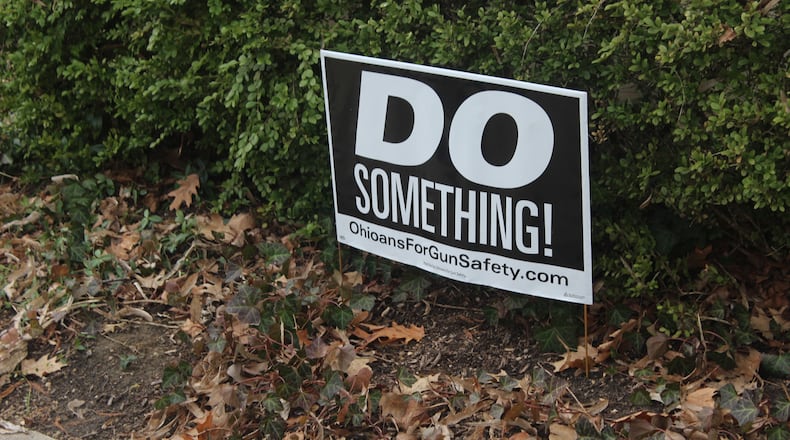“I can’t believe it’s been five years,” state Rep. Willis Blackshear, Jr., D-Dayton, told this news outlet. “As a state, we have to ask ourselves, ‘What have we done since then to prevent another tragedy like the one that happened Aug. 4, 2019, from happening again?’”
Nine innocent bystanders were killed that day and more than two dozen others were injured. The perpetrator, Connor Betts, 24, of Bellbrook, used a legally-bought semiautomatic pistol equipped with a stabilizing brace to convert it into a rifle, and a drum magazine that could hold up to 100 .223-caliber rounds. He fired 41 bullets in less than one minute before he was shot and killed by Dayton police.
Blackshear said he attended the Oregon District vigil the day after the shooting — the same gathering where a conciliatory DeWine was interrupted by a crowd demanding that he “do something” besides offer thoughts and prayers.
“That was a call for help. And nothing has been done to, I believe, make us go in the right direction as a state,” Blackshear said.
There have been plenty of attempts, starting just days after the shooting when DeWine released a list of gun law changes and mental health reforms that he characterized as a comprehensive approach to tackle Ohio’s everyday gun violence and to limit mass shootings.
“I have an obligation to do this. This is something I want to do. We’re focused on this. It’s the right thing to do. These are all things that I believe we can do,” DeWine said.
The governor’s gun-specific wish list included a “red flag law” to allow the state to take gun access away from Ohioans ruled by a judge to be a danger unto themselves and others; enhanced background check parameters to limit unchecked sales; and a host of increased criminal penalties centered around firearms.
Those suggestions were folded into a bill carried by Sen. Matt Dolan, R-Chagrin Falls, and backed by then Sen. Peggy Lehner, R-Kettering, who now serves as Kettering mayor.
In 2019, nothing came of it.
In 2022 it was reintroduced and, again, nothing came of it.
In the current 135th General Assembly, DeWine’s framework has been almost completely out of play.
“It was good intentions,” said Jim Irvine, the former and longtime president of the Buckeye Firearms Association who for months collaborated with the DeWine administration after the Oregon District shooting. “However, it didn’t pass because it wasn’t good legislation, is the bottom line. It wasn’t going to solve a problem.”
‘What do you do?’
Irvine stands in a somewhat rare position: A gun-rights activist intent on working with politicians who have an appetite to limit gun access in some way. While he holds a sacrosanct view of the Second Amendment, he also believes that “any rational person can agree there are people who should not possess guns.”
Still, Irvine called the red flag provision within the bill “horrible.” He argued that even if everyone agrees that an individual shouldn’t have access to a gun, that person should still get their due process before their property is seized. Real due process, he continued, includes being notified, being given time to find an attorney, and being given your day in court — which creates its own safety problems.
“You can’t have a guy who everyone agrees is unsafe and tell him, ‘Hey, in three days we’re going to come back and knock on your door and haul you into court’ and then leave him there with all the guns,” Irvine said. “So what do you do? I don’t know what you do. We never found an answer, but it wasn’t for a lack of trying, either on our part or on the governor’s part.”
Red flag laws received particular attention following the Oregon District shooting due to the gunman’s extensive history with threatened violence.
A 2019 Dayton Daily News investigation found that he once mentioned opening fire at a Dayton bar to his friend. Another time he held a knife to a friend’s throat. In high school, he was suspended for having a “hit list” that became public. An ex-girlfriend told this news outlet that the shooter had, on several occasions, put a pistol in his mouth with the intent to end his life.
Former Dayton Police Chief Richard Biehl, who helmed the department at the time of the mass shooting, told this news outlet that he wished Ohio would have followed in the footsteps of Florida, whose lawmakers instituted a red flag law following the 2018 mass shooting at Marjory Stoneman Douglas High School, in which 17 people were killed.
“Red flag laws absolutely need to be addressed,” Biehl said.
State Rep. Sara Carruthers, R-Hamilton, a gun owner, told this news outlet that she generally viewed red flag laws to be sensible.
“I certainly think if a person has a mental illness and the family knows it, and everyone around knows it, and it has been reported on many, many times, something should be done to keep firearms away from that person and to protect everybody else,” said Carruthers
The Butler County lawmaker said there’s “room for another discussion on it,” but expressed doubt that a red flag law would be politically feasible in Ohio.
Other proposals
Irvine and other gun-rights activists poked holes in the rest of DeWine’s framework, too, and now the proposals lay dormant in the GOP-dominated General Assembly.
For example, Irvine doubted the benefit of expanding background checks because “almost every mass killer passes a background check the morning of,” and the repeat criminals responsible for a hefty portion of the state’s gun violence are already barred from legal gun purchases — “How they get them is they steal them,” he said.
Despite his issues with the legislation, Irvine said he encouraged DeWine and Lt. Gov. Jon Husted to officially introduce it to the Ohio General Assembly in hopes that someone else might be able to come up with agreeable solutions.
“‘We’ve been batting this around for months and we’ve worked on it and we haven’t found a solution, so let’s introduce and see what happens,’” he recalled telling the administration. “And of course, what happened is: Everybody gets tied to their positions and it becomes a mess and nothing ever happens because so many entities are more interested in fundraising and arguing their nonsense than they are in actually solving a problem.”
When asked if DeWine’s gun safety proposals are still a priority, a spokesperson said the governor “believes in taking action” and pointed toward the work DeWine has done on “increasing mental health care access, providing training to law enforcement and assisting with critical incidents, helping make K-12 schools safer, and providing resources for higher education.”
“While we often see tragedies when people slip through the cracks and do not receive services, (we) will never know how many people received help and avoided crisis because of the work done to prevent such tragedies,” said Dan Tierney, press secretary for DeWine. “These efforts are often the best way to serve people.”
Dem bills go nowhere
DeWine’s fruitless gun priorities are at the start of an increasingly long list of gun safety initiatives that have ultimately been ignored post-2019. Democrats, with feeble numbers in the Ohio House and Senate, have long tried to pass their own legislation, but those bills have generally been ignored by House and Senate leadership.
Take, for example, House Bill 433, introduced by Blackshear in February to reinstate Ohio’s ban on magazines that can hold more than 30 rounds of ammunition — a ban that was lifted four years before the Oregon District shooter used a double drum, 100-round magazine to devastating effects.
Credit: Ohio House Democratic Caucus
Credit: Ohio House Democratic Caucus
“We simply want to go back to the commonsense regulation Ohio had in place before 2015 — a regulation that recognized that there’s simply no benefit to society that can outweigh the dramatic increase in killing power a magazine with more than 30 rounds in it conveys to its user,” Blackshear told the House Government Oversight Committee in June.
Blackshear’s proposal was part of a flurry of gun safety bills introduced by Democrats in early 2024. Others included proposals to establish a gun violence task force (House Bill 421); to bar Ohioans convicted of domestic violence from owning a firearm (House Bill 417) or to mandate universal background checks (House Bill 419).
Gun rights debate
None of the Democratic bills have been given more than a single hearing. Blackshear said House Speaker Jason Stephens, R-Kitts Hill, told him his bill won’t get another hearing, which, in effect, blocks Ohio proponents and opponents alike from being able to weigh in.
“I believe that the people should have a right to at least have multiple hearings on these bills,” Blackshear said, “so we can hear from the proponents and the opponents of this legislation just so we can get a sense of exactly what folks in Ohio want to do.”
Blackshear is running for Ohio Senate this year against Ohio Board of Education member Charlotte McGuire, a Republican. The winner in November will represent Dayton and several surrounding suburbs in the Ohio Senate.
McGuire has told this news outlet she could support gun control measures such as closing loopholes that allow individuals to buy a firearm without a background check, and would be willing to consider banning high-capacity magazines.
“We’re talking about military-type weapons,” she said while running unopposed in the GOP primary. “Why would you need that for self and family and community defense? That’s the question we have to resolve.”
She said she also supports gun rights and an individual’s right to defend themselves.
“I’m for secured freedoms and safe communities,” she said.
While Democrats’ bills on gun reform have stalled, they have watched as Republicans have expanded Ohioans’ gun rights.
The approval of gun-rights bills since the Oregon District shooting include a “stand your ground” law, which increases the number of scenarios in which an individual is justified for opening fire on another, and a permit-less concealed carry law for Ohio adults.
For more stories like this, sign up for our Ohio Politics newsletter. It’s free, curated, and delivered straight to your inbox every Thursday evening.
Avery Kreemer can be reached at 614-981-1422, on X, via email, or you can drop him a comment/tip with the survey below.
About the Author






